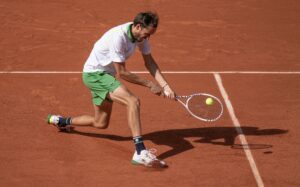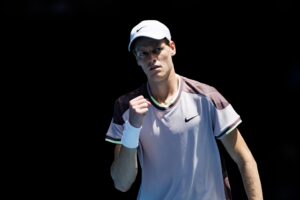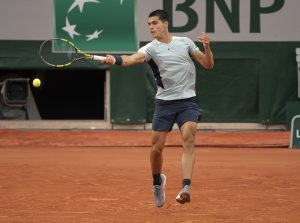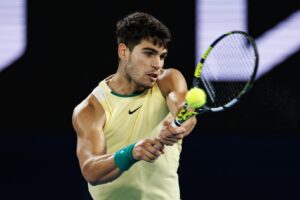Day 4 at Wimbledon 2018 was probably the best day in the recent history of Australian tennis, at least at a Grand Slam. The country that for much of the 20th century was one of the two tennis superpowers (alongside America) has been in decline for much of the 21st century (again, exactly like America). Although one single day and a succession of Australian wins do not prove that Australian tennis is once again on the way to global domination, they are at least very healthy signs.
Three Australian players in particular caught the imagination, not just of their own country but of the tennis world, with their performances on day four.
NICK KYRGIOS
Of course, Kyrgios is the great hope of Australian tennis, at least on the men’s side. As he proved yet again in his straight-sets win over Robin Haase of the Netherlands, he is undeniably attractive to watch or, to use the term that is so often used these days, he is “box office”. His combination of apparently effortless but none the less gigantic serving and groundstrokes, allied to the deftest of touches (most evident in the pair of “hot dogs” or “tweeners” that he played in one rally), make him, in theory at least, the quintessential 21st-century tennis player.
The biggest problem for Kyrgios has always been insurmountable, namely that tennis is an individual and not a team sport. He has always professed his love for basketball (arguably the ultimate team sport, in that players have to both attack and defend continuously) and contrasted it with the isolation, or even loneliness, of tennis.
However, Lleyton Hewitt’s successful reintegration of Kyrgios to the Australian Davis Cup team (after Kyrgios had clashed repeatedly with the previous captain, Pat Rafter) seems to have made a difference to Kyrgios’s approach to the game. He now appears less alone and less frustrated, not just in Davis Cup ties but in individual tournaments.
Also, of all the Australian players on view at Wimbledon, Kyrgios may be the one who will most benefit from the raucous support that he will enjoy from Australian fans. In the past, even the greatest Australian champions such as Rod Laver and Margaret Court would joke about Australian players having the luxury of two home Slams – the Australian Open, of course, and Wimbledon – because there are so many Australians in London.
If anyone can ride the wave of adulation that Australian tennis fans provide for their compatriots at Wimbledon, it might just be Kyrgios. At the very least, as they chant and holler, he can temporarily forget that he is on a tennis court and imagine that he is on a basketball court, enjoying all the “home court” advantage that such support provides.
ASHLEIGH BARTY
To continue the basketball theme, Ashleigh Barty has already achieved what the great Michael Jordan could not, by playing two professional sports to a high level. (For all his domination of the NBA, Jordan only ever made it to the minor leagues in baseball.) Such is her natural strength and athleticism, alongside the apparently innate Australian love of cricket, that Barty has already played in the women’s Big Bash cricket tournament back home, but of course it is tennis that is her main sport. And as she showed in the second round at Wimbledon, she now seems to be focusing on tennis in a way that will finally allow her to excel at one sport rather than being merely impressive in two.
Barty’s second-round clash with Canada’s Eugenie Bouchard was the clash of the former junior Wimbledon champions, Barty having won the girls’ singles title in 2011 and Bouchard triumphing a year later. However, while Barty finally appears to be on an upwards curve in her career, the graph seems to be pointing resolutely downwards for Bouchard. Frankly, it is no wonder that Bouchard is continuing her legal action against the US Tennis Association for the tumble she took on an allegedly wet floor at the US Open in 2015, because she now appears almost unrecognisable from the youthful prodigy who reached the women’s singles final at Wimbledon in 2014.
By contrast, Barty at last appears to be making the most difficult transition in sport (indeed, in life itself), from precocious youth to wise adult. Against Bouchard, she was almost Kyrgios-like in her combination of awesome power and breathtaking ball control, with one sliced drop-shot off a Bouchard serve proving the highlight of her performance. The fact that she could decimate Bouchard in the second and final set, reeling off five successive games to go from 5-2 down to winning 7-5, was almost Federer-like (and there there is obviously no higher compliment in tennis).
ALEX DE MINAUR
The third member of what might be called the new Aussie holy trinity of tennis players is Alex de Minaur. He also won on day four, beating France’s Pierre-Hugues Herbert to win his second-round tie. Unlike Kyrgios and Barty, he did not win in straight sets, but he was facing probably the most difficult opponent that any Australian player has faced so far. In the end, he won in four sets, which included a fairly epic second-set tiebreak that he eventually won 10-8, to join his compatriots in the third round.
De Minaur’s story illustrates how Australian tennis (indeed, tennis around the world) has changed considerably in the last few decades. Although he was born in Sydney, de Minaur spent much of his childhood in his mother’s homeland of Spain. Consequently, his tennis has largely been learned on the clay courts of Spain rather than on the Aussie grass courts that produced so many of the greatest serve-and-volleyers in tennis, from Laver and Court to Rafter and Hewitt.
As a result, De Minaur’s best chance of eventually competing for and even winning a Major may come at Roland Garros rather than at Wimbledon. Nevertheless, in defeating such an accomplished player as Herbert, who was part of France’s Davis Cup winning team last year, he showed that he can also be a force at Wimbledon, starting this year.
AND THE OTHER AUSSIES?
Perhaps the most impressive aspect of the Australian performances on day four at Wimbledon was the fact that there were so many of them, and not just the aforementioned three. However, two other performances by Australian players offer contrasting signs for the future of Australian tennis.
On the plus side, there was Daria Gavrilova’s win over Sam Stosur, the last Australian woman or man to win a Major (the 2011 US Open). Gavrilova may originally hail from Moscow, but she showed all the archetypal Australian qualities of spirit and determination to blow Stosur away in straight sets, 6-4, 6-1.
On the debit side, however, there was Bernard Tomic’s defeat in four sets to Kei Nishikori, which prevented another all-Aussie clash (against Kyrgios) in the fourth round. Unfortunately, Tomic must serve as the cautionary tale for all young tennis players, and not just Australian ones. His descent down the rankings after his youthful breakthrough (he reached the Wimbledon quarterfinal in 2011, when he was only 18) has been truly depressing to watch. Indeed, it now appears irreversible.
Of course, exactly like Kyrgios Tomic has often professed his lack of love for tennis, maintaining that it has only ever been a job and not an all-consuming obsession. In that respect, he is not alone, as even some of the greatest champions (notably Andre Agassi and Pat Cash) have admitted to having similar feelings about the sport. However, unlike Agassi and Cash, Tomic appears unable to put his own ambivalent feelings about tennis to one side in order to play the game. It is to be hoped that Kyrgios, his successor as the great hope of Australian tennis, can emulate the achievements of Agassi and Cash, rather than ending up in the tennis wilderness like Tomic.
Main Photo:
Embed from Getty Images






